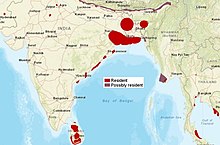
Back قط سماك Arabic قط سماك ARZ মেচেকা Assamese Wirikol (Prionailurus viverrinus) AVK Balıqtutan pişik Azerbaijani بالیق توتان پیشیک AZB Кот-рыбак Byelorussian Кот-рыбак BE-X-OLD Котка рибар Bulgarian মেছোবাঘ Bengali/Bangla
| Fishing cat | |
|---|---|

| |
| Scientific classification | |
| Domain: | Eukaryota |
| Kingdom: | Animalia |
| Phylum: | Chordata |
| Class: | Mammalia |
| Order: | Carnivora |
| Suborder: | Feliformia |
| Family: | Felidae |
| Subfamily: | Felinae |
| Genus: | Prionailurus |
| Species: | P. viverrinus
|
| Binomial name | |
| Prionailurus viverrinus (Bennett, 1833)
| |

| |
| Distribution of the fishing cat as of 2016[1] | |
The fishing cat (Prionailurus viverrinus) is a medium-sized wild cat of South and Southeast Asia. It has a deep yellowish-grey fur with black lines and spots. Adults have a head-to-body length of 57 to 78 cm (22 to 31 in), with a 20 to 30 cm (7.9 to 11.8 in) long tail. Males are larger than females weighing 8 to 17 kg (18 to 37 lb); females average 5 to 9 kg (11 to 20 lb). Since 2016, it is listed as Vulnerable on the IUCN Red List. Fishing cat populations are threatened by destruction of wetlands and have declined severely over the last decade. The fishing cat lives foremost in the vicinity of wetlands, along rivers, streams, oxbow lakes, in swamps, and mangroves.
The fishing cat's main prey is fish. Other prey items include birds, insects, small rodents; molluscs, reptiles including snakes, amphibians and carrion of domestic cattle. The fishing cat is thought to be primarily nocturnal. It is a good swimmer and can swim long distances, even under water. The species is the state animal of West Bengal. As of 2015, there are estimated to be 10,000 living individuals.
- ^ a b c Mukherjee, S.; Appel, A.; Duckworth, J.W.; Sanderson, J.; Dahal, S.; Willcox, D.H.A.; Herranz Muñoz, V.; Malla, G.; Ratnayaka, A.; Kantimahanti, M.; Thudugala, A.; Thaung, R. & Rahman, H. (2022) [errata version of 2016 assessment]. "Prionailurus viverrinus". IUCN Red List of Threatened Species. 2016: e.T18150A50662615. doi:10.2305/IUCN.UK.2016-2.RLTS.T18150A221434864.en. Retrieved 10 August 2023.
© MMXXIII Rich X Search. We shall prevail. All rights reserved. Rich X Search
